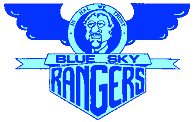- History
- Hardware
- Game List
- Mattel Electronics
- Activision
- Atarisoft
- Coleco
- Dextell
- Imagic
- Interphase
- INTV Corporation
- Body Slam
- Chip Shot
- Choplifter
- Commando
- Deep Pockets
- Dig Dug
- Diner
- Flight Simulator
- Hover Force
- Learning Fun I
- Learning Fun II
- Mountain Madness
- Pole Position
- Slam Dunk
- Slap Shot
- Spiker
- Stadium Mud Buggies
- Super Pro Decathlon
- Super Pro Football
- Thin Ice
- Thunder Castle
- Tower of Doom
- Triple Challenge
- World Championship Baseball
- Parker Brothers
- Sega
- Instructions
- ABPA Backgammon Instructions
- Advanced Dungeons & Dragons
- AD&D Treasure of Tarmin
- Armor Battle
- Astrosmash
- Auto Racing
- B-17 Bomber
- Bodoy Slam
- Bomb Squad
- Boxing
- Bump 'N' Jump
- BurgerTime
- Buzz Bombers
- Checkers/Draughts
- Chip Shot:Super Pro Golf
- Commando
- Deep Pockets
- Dig Dug
- Diner
- Electric Company Math Fun
- Electric Company Word Fun
- Frog Bog
- Horse Racing
- Hover Force
- Kool-Aid Man
- Las Vegas Poker & Blackjack
- Learning Fun I
- Learning Fun II
- Lock 'N' Chase
- Loco-Motion
- Major League Baseball
- Masters of the Universe:The Power of He-Man
- Mission X
- Motocross
- Mountain Madness: Super Pro Skiing
- NASL Soccer
- NBA Basketball
- NFL Football
- NHL Hockey
- Night Stalker
- PBA Bowling
- PGA Golf
- Pinball
- Pole Position
- Reversi
- Royal Dealer
- Sea Battle
- Shark! Shark!
- Sharp Shot
- Slam Dunk
- Slap Shot
- Snafu
- Space Armada
- Space Battle
- Space Hawk
- Space Spartans
- Spiker!
- Stadium Mud Buggies
- Star Strike
- Sub Hunt
- Super Pro Decathlon
- Super Pro Football
- Takeover
- Tennis
- Thin Ice
- Thunder Castle
- Tower of Doom
- Triple Action
- Triple Challenge
- TRON Deadly Discs
- TRON Maze-a-Tron
- TRON Solar Sailer
- US Ski Team Skiing
- USCF Chess
- Utopia
- Vectron
- World Championship Baseball
- M Network
- ADD Tarmin
- ADD Tower of Mystery
- Adventures of TRON
- Air Raiders
- Armor Ambush
- Astroblast
- Bump 'N' Jump
- BurgerTime
- Dark Cavern
- Frogs and Flies
- In Search of the Golden Skull
- International Soccer
- Kool-Aid Man
- Lock 'N' Chase
- Masters of the Universe
- Rocky and Bullwinkle
- Sea Battle
- Space Attack
- Star Strike
- Super Challenge Baseball
- Super Challenge Football
- Swordfight
- TRON Deadly Discs
- Other Unreleased 2600 Titles
- Bump 'N' Jump - Coleco
- BurgerTime - Coleco
- Illusions- Coleco
- Masters of the Universe - Coleco
- M-Network Computer Software
Space Hawk
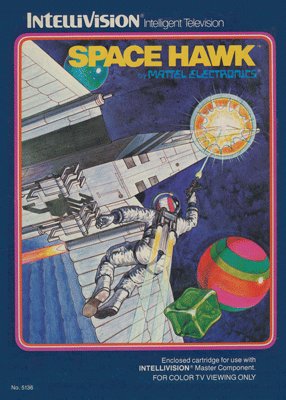
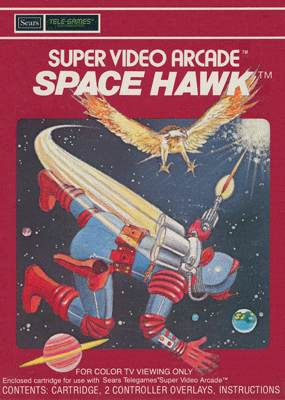
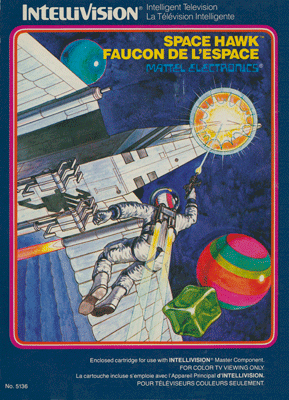
INTELLIVISION CARTRIDGE [Mattel Electronics #5161]
Release #28 April 19, 1982
Also released by Sears
Design/Program: Bill Fisher, John Sohl
Graphics & Sound: Bill Fisher
Package illustration: Jerrol Richardson
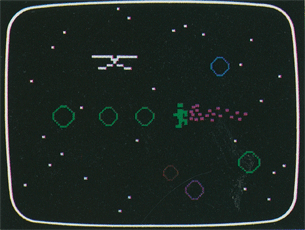
1982 CATALOG DESCRIPTION
You're equipped with a jetpack for directional avoidance control, a blaster for protection and 5 force shields. If you get hit, you lose a shield. Not only that, you're sent into a space spin that could be disastrous. While you're regaining control, UFOs and comets scream past you. Of course, you can use hyperspace to get out of a super-tight spot. That'll put a few million light years between you and danger. But, watch out. You could wind up in an even hotter spot. If you want to find out how good you are, invite a friend over, compare scores.
• One player game
• As your score goes up, the game automatically becomes more challenging
• Laser fire and maneuvering options add variety
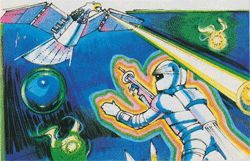
PRODUCTION HISTORY
Most new programmers started their first day with a copy of a simple training game called Killer Tomatoes. They were expected to spend a few weeks playing with it and modifying it to get a feel for how the Intellivision system worked before being assigned to a real game.
Bill Fisher, however, had a different training game. On his first day in June 1981 he was given John Sohl's original Asteroids version of Astrosmash. He was told to modify it into a game that would still be like Asteroids, but different enough that the Mattel lawyers would allow it to be released. Space Hawk was the result. (And while he was at it, he fixed the bug in displaying the score.)

FUN FACT: While testing the game, Bill came across a bug: every now and then, the game would, seemingly at random, hyperspace you. He and his boss, Mike Minkoff, went over the code with a fine-tooth comb before realizing what the problem was: the Intellivision hand controllers encode button presses in such a way that an action (side) key pressed at the same time as particular directions on the disc will be interpreted instead as a numeric key being pressed. There was no software way around this; shooting while moving would occasionally be interpreted as pressing 9 -- the hyperspace button.
After several days of puzzling over a solution, the bug was ultimately "fixed" by including the following note in the instruction manual:
"Every once in a while, your space hunter will move near a 'black hole,' and the computer will automatically put him into HYPERSPACE. This will cost you the same number of points as if you had pressed the HYPERSPACE key yourself. On the other hand, it will save your hunter."
This led to an axiom frequently heard around Mattel: If you document it, it's not a bug -- it's a feature. Anytime a game in development crashed -- no matter how badly or bizarrely -- witnesses would invariably turn to the frustrated programmer, shrug, and calmly say "document it."
